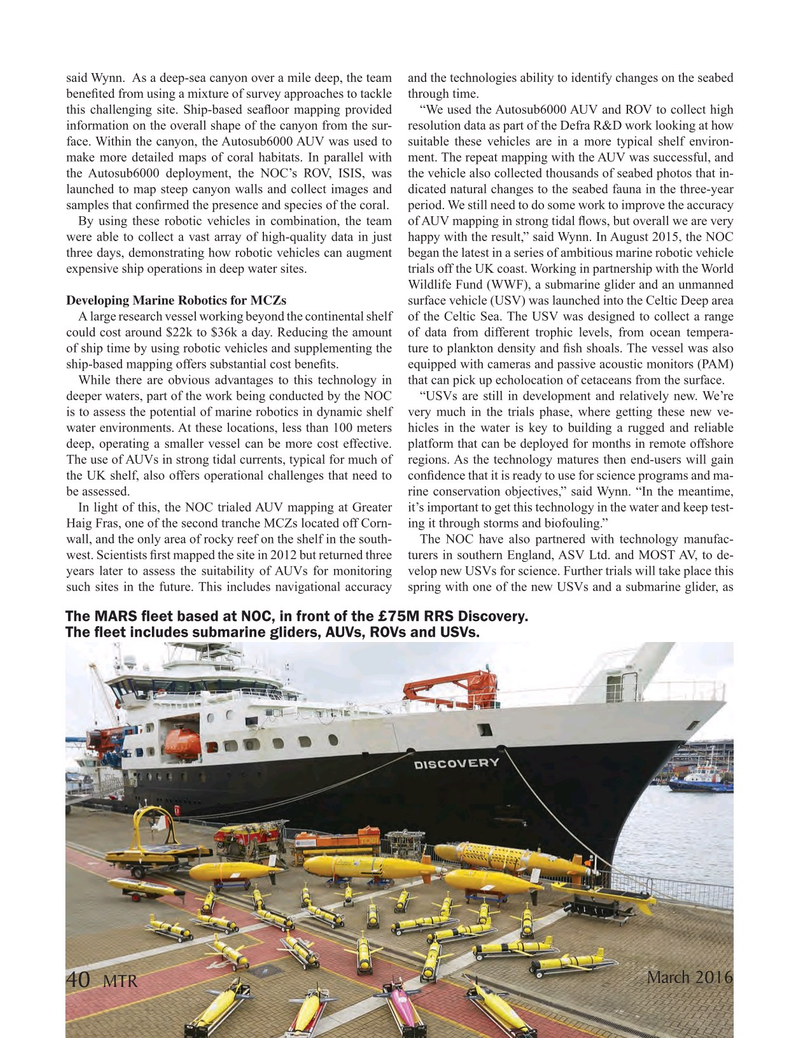
Page 40: of Marine Technology Magazine (March 2016)
Oceanographic Instrumentation: Measurement, Process & Analysis
Read this page in Pdf, Flash or Html5 edition of March 2016 Marine Technology Magazine
said Wynn. As a deep-sea canyon over a mile deep, the team and the technologies ability to identify changes on the seabed bene? ted from using a mixture of survey approaches to tackle through time.
this challenging site. Ship-based sea? oor mapping provided “We used the Autosub6000 AUV and ROV to collect high information on the overall shape of the canyon from the sur- resolution data as part of the Defra R&D work looking at how face. Within the canyon, the Autosub6000 AUV was used to suitable these vehicles are in a more typical shelf environ- make more detailed maps of coral habitats. In parallel with ment. The repeat mapping with the AUV was successful, and the Autosub6000 deployment, the NOC’s ROV, ISIS, was the vehicle also collected thousands of seabed photos that in- launched to map steep canyon walls and collect images and dicated natural changes to the seabed fauna in the three-year samples that con? rmed the presence and species of the coral. period. We still need to do some work to improve the accuracy
By using these robotic vehicles in combination, the team of AUV mapping in strong tidal ? ows, but overall we are very were able to collect a vast array of high-quality data in just happy with the result,” said Wynn. In August 2015, the NOC three days, demonstrating how robotic vehicles can augment began the latest in a series of ambitious marine robotic vehicle expensive ship operations in deep water sites. trials off the UK coast. Working in partnership with the World
Wildlife Fund (WWF), a submarine glider and an unmanned
Developing Marine Robotics for MCZs surface vehicle (USV) was launched into the Celtic Deep area
A large research vessel working beyond the continental shelf of the Celtic Sea. The USV was designed to collect a range could cost around $22k to $36k a day. Reducing the amount of data from different trophic levels, from ocean tempera- of ship time by using robotic vehicles and supplementing the ture to plankton density and ? sh shoals. The vessel was also ship-based mapping offers substantial cost bene? ts. equipped with cameras and passive acoustic monitors (PAM)
While there are obvious advantages to this technology in that can pick up echolocation of cetaceans from the surface. deeper waters, part of the work being conducted by the NOC “USVs are still in development and relatively new. We’re is to assess the potential of marine robotics in dynamic shelf very much in the trials phase, where getting these new ve- water environments. At these locations, less than 100 meters hicles in the water is key to building a rugged and reliable deep, operating a smaller vessel can be more cost effective. platform that can be deployed for months in remote offshore
The use of AUVs in strong tidal currents, typical for much of regions. As the technology matures then end-users will gain the UK shelf, also offers operational challenges that need to con? dence that it is ready to use for science programs and ma- be assessed. rine conservation objectives,” said Wynn. “In the meantime,
In light of this, the NOC trialed AUV mapping at Greater it’s important to get this technology in the water and keep test-
Haig Fras, one of the second tranche MCZs located off Corn- ing it through storms and biofouling.” wall, and the only area of rocky reef on the shelf in the south- The NOC have also partnered with technology manufac- west. Scientists ? rst mapped the site in 2012 but returned three turers in southern England, ASV Ltd. and MOST AV, to de- years later to assess the suitability of AUVs for monitoring velop new USVs for science. Further trials will take place this such sites in the future. This includes navigational accuracy spring with one of the new USVs and a submarine glider, as
The MARS ? eet based at NOC, in front of the £75M RRS Discovery.
The ? eet includes submarine gliders, AUVs, ROVs and USVs.
March 2016 40
MTR
MTR #2 (34-49).indd 40 2/19/2016 11:49:09 AM

 39
39

 41
41
